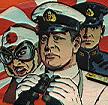ORIGINAL: anarchyintheuk
Take Coral Sea, Eastern Solomons, Santa Cruz, Phillipine Seas then. Besides CarDiv 5 incorrectly identifying and whacking the Neosho, I can't think of another example where a sctf or other non-cvtf was incorrectly identified as a cvtf and attacked or, if a cvtf was correctly identified, the strike force failed to reach it.
Upon receipt of the search planes' report of contact with enemy carriers, Admiral Kinkaid ordered an attack group launched to strike the Shokaku and what was thought to be the Zuikaku, now steaming about 210 miles to the northwest of Task Force KING. Beginning at 0830, the Hornet launched two waves of planes. The first consisted of 15 SBD-3's of Bombing Squadron EIGHT and Scouting Squadron EIGHT, 6 TBF-1's of Torpedo Squadron SIX, and 8 F4F-4's of Fighting Squadron 72.
The second Hornet wave, which began taking off at 0915, was made up of 9 SBD-3's and 9 TBF-1's, with 7 F4F-4's as escorts. The Group Commander, Comdr. Walter F. Rodee, took off with this flight in a TBF....
....The second Hornet wave proceeded out to the end of its leg and observed "a group of enemy cruisers and destroyers." (One pilot described the enemy formation thus: "At 160 miles out an enemy DD was sighted, followed at a great distance by a CA and other forces all strung out heading toward our force.") This again was presumably the section of Enemy Task Force No. 2 which was perhaps screening the Zuikaku's retirement.
After scouting to the north and west beyond this line of ships and finding nothing, our planes concluded that the enemy carriers were out of range. The leader of the dive bombers, Lieut. John J. Lynch, thereupon called the Group Commander and stated that unless otherwise directed he would attack a heavy cruiser of the Tone class which was throwing up considerable antiaircraft fire.
Receiving no reply, Lieut. Lynch pushed over at 1040 and led an attack from 11,500 feet. Four certain and one probable 1,000-pound hits were made on the selected cruiser, which was later identified as the Chikuma. Flames and smoke blanketed the target, but she continued to steam at reduced speed. As the dive bombers retired to the east, the Chikuma was rocked by a heavy explosion.
The above narrative occured during the battle of Santa Cruz islands. Note that the enemy's carriers were already discovered, and Hornet launched two attack about 45 minutes apart. Both were launched on the same intel. The first finds and attacks the carriers, the second finds no carriers and attacks a SAG instead.
That being said, I do agree with the majority of those here. I can understand a portion of a carrier strike attacking minor units (as happened above), but 108? Had I been the TF commander I would have shot every group leader after he landed.





